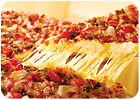
Photo courtesy Chr. Hansen.
Today's cheesemakers are continuously looking for ways to not only differentiate their products in the marketplace, but also provide cost savings and efficiency in their manufacturing process.
For example, there's a new enzyme solution available to manufacturers of mozzarella and pizza cheese that can increase yield by about 2%. Many manufacturers of such cheese are also very interested with increasing production rates. There are cultures designed specifically for high-volume manufacturing that produce high-quality cheese with consistent moisture, pH, texture and flavor, along with reduced risk of contamination and improved phage resistance.
There are also functional milk proteins available to help manufacturers produce low-fat cheese that they can be proud of. Optimizing cheese structure, the proteins overcome the rubbery texture often associated with fat reduction. Cheese gains a full-fat consistency even when half the fat is removed. Ongoing development of the proteins means they can be adapted to most cheese types, thus improving low-fat cheese quality and cutting costs for manufacturers who can reduce the content of cream in their recipes. Yield is increased due to the proteins' strong water-binding capacity.
Designed to cut costs and improve efficiency by speeding up the cheese maturation process, new enzymes have demonstrated a three-month reduction of Cheddar cheese maturation time. The new ingredient does not contain any extra, unwanted enzymes. This purity means that its work is not disrupted by the side effects of other enzymes, which can result in off-tastes. The new enzyme is marketed for its ability to eliminate bitter peptides that may be formed during the cheese maturation process by culture bacteria or other enzymes. And because of the enzyme's pH profile, it does not interfere with whey processing. The enzyme remains relatively inactive at the high pH levels in the early stages of cheesemaking (around pH 5.5), allowing the whey and curd to separate without interference. Once these have separated and the lactate produced acidifies the curd, the pH level goes down and the enzyme comes into action.
Cheese also exhibits a seemingly infinite capacity to take on new forms, flavors and functions. "Technology and innovation can take ideas and turn them into marketable products," say Rusty Bishop, director of the Wisconsin Center for Dairy Research (WCDR) at the University of Wisconsin-Madison. Opportunities exist in the area of kid-oriented cheeses in novel colors and flavors, as well as innovations in upscale process cheese.
For example, parents wanting to feed their children wholesome foods often seek cheeses that are lower in fat and higher in protein. Kids, on the other hand, want foods that are fun and great-tasting. To satisfy both groups, Dairy Management Inc., Rosemont, Ill., funded research that identified techniques for adding new flavors and colors to process cheese and mozzarella, while also controlling fat content and performance characteristics.
In the case of process cheese, proper selection of melting salts is key to delivering the desired melt and body characteristics, with flavors such as cotton candy, bubble gum, green apple and watermelon added during the heating and mixing step. For mozzarella cheese, flavors and bright colors are added after the pasta-filata step in a dry mixer.
Indeed, a great deal of opportunity exists in the area of process cheese, a business many cheesemakers don't always pursue because of its "recipe" approach. However, it is precisely the consistent product produced by this approach that makes process cheese very attractive to prepared foods formulators looking to include cheese in their products.

Cheese melt can be manipulated through cheese ingredient selection. Photo courtesy Domino's Pizza.
Controlling cheese melt and texture is accomplished by modifying proteins. It is especially important to control the degree of proteolysis in the cheese, which is the degree milk proteins are broken down, the pH of the cheese during manufacturing and the final pH, and the ratios of protein to moisture or protein to fat, also known as protein density.
Controlling all of these variables can be very challenging for the natural cheese cheesemaker, particularly when standards of identity dictate some of the processing and ingredient variables. Process cheese is all about controlling functionality.
In the manufacture of process cheese, a cheesemaker starts out with a minimum amount of specified natural cheese that is blended with other ingredients including those with emulsifying properties (emulsifiers are not allowed in natural cheese), followed by a high-heat treatment. High temperatures separate the natural cheese into a fat and serum phase. The emulsifying salts must be added to shift the pH, solubilize the proteins and sequester the calcium ions. Various citrates, phosphates and polyphosphates help form stable emulsions. Careful selection of the appropriate blends of emulsifying salts produces a process cheese with the desired characteristics of firmness, melt and smoothness.
WCDR researchers are pursuing technologies to manufacture process versions of non-standardized typically natural cheeses such as camembert and feta, as well as various Hispanic-styles cheeses. The key in this effort is to achieve desired slicing and shredding characteristics, along with consistent melt without sacrificing authentic flavor.
Researchers have also been working on creating highly flavorful process cheeses. The economical advantage for prepared foods manufacturers is obvious-you use less cheese. However, from a formulation standpoint, fewer adjustments need to be made to the formula or process to adjust for the addition of the cheese. And in the end, the customer tastes and sees the cheese in the product.
Sidebar: More Vitamin D Now Allowed in Cheese
In the Nov. 16, 2005, issue of theFederal Register, FDA ruled that cheesemakers can fortify most cheese and cheese products with vitamin D3at a higher level than previously allowed. Enhancing cheese with the new allowable amount of vitamin D3permits many of these products to claim an "excellent" source of vitamin D on the label.Products covered by the regulation change are natural cheese, process cheese, cream cheese, and cheese spreads and dips. Cheeses not included are hard-grating cheeses with smaller reference amounts, such as Parmesan and Romano, and cheeses with larger reference amounts, such as cottage cheese or ricotta cheese.
Prior to the ruling, milk products (including cheese and cheese products) could be fortified with vitamin D at levels up to 89 international units (IUs) per 100g. The new rule raises that level to 81 IUs of vitamin D3per 30g, or nearly three times the former level. This equates to a level just slightly above 20% of the Daily Value (DV). A product containing 10% to 19% of the DV of a nutrient per reference serving can claim on the label that it is a "good source" of the nutrient. A product containing 20% or more of the DV of a nutrient per reference serving is considered an "excellent source."
According to research, few Americans consume the recommended amounts of Vitamin D. In fact, the 2005 Dietary Guidelines Advisory Committee identified vitamin D as a "shortfall" vitamin in the elderly, persons with dark skin and persons exposed to insufficient sunlight. The current recommended intake of vitamin D is 200 IUs up to age 50, 400 IUs between the ages of 51 and 70, and 600 IUs after age 70. However, high-risk groups and possibly others may need substantially more than the current recommended intakes. Vitamin D is important to health because it helps the body absorb and retain calcium and phosphorus, both critical for building bone.
This new FDA rule provides the dairy industry with a viable option for further improving the nutrition profile of cheese and cheese products, and thus the nutritional status of its consumers, both young and old.

